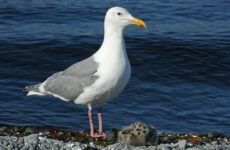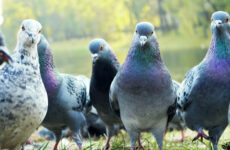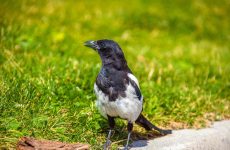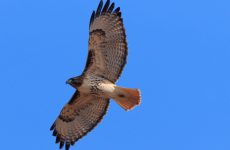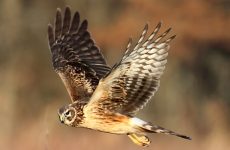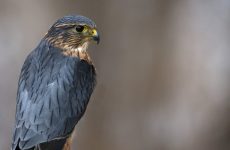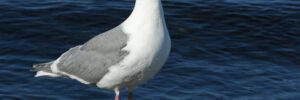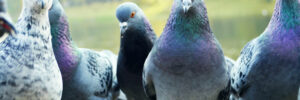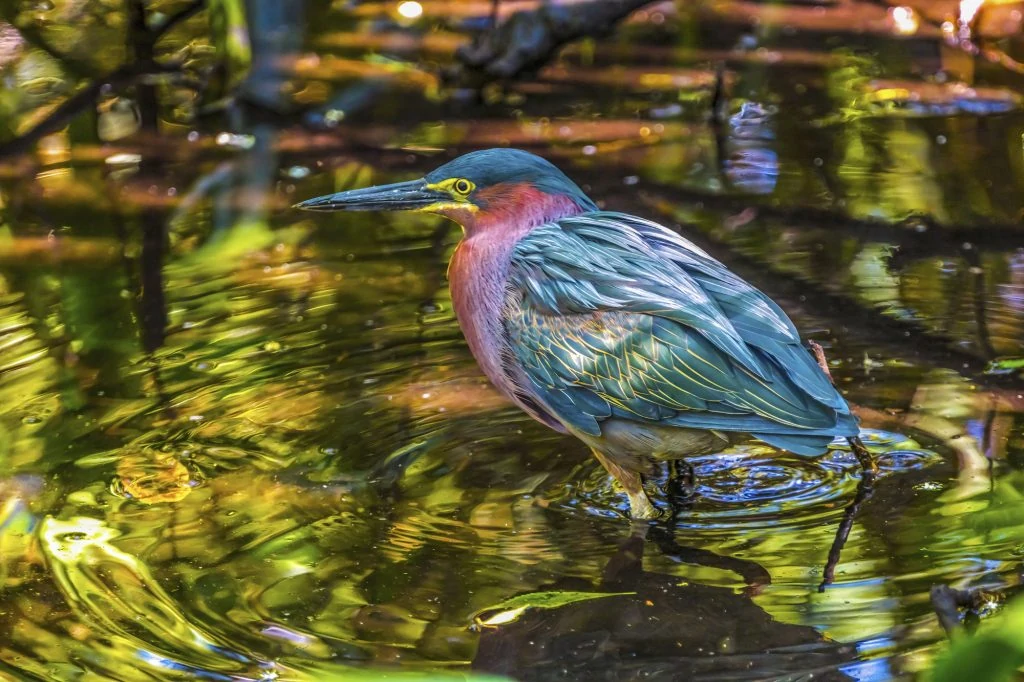
Herons are water-loving birds found in saltwater, freshwater, or even peering into your backyard pond for a quick snack.
However many of your fish herons eat, they are protected, so a net is your best bet if you’re having trouble.
Herons often nest in large colonies called heronries but tend to hunt alone by standing perfectly still and waiting or by dashing about to stir up the prey.
There are a surprising number of names for a group of herons, and these include “rookery”, “battery”, “hedge”, “siege”, “pose”, and “scattering” of herons, to name a few!
If you enjoy spotting waterbirds in Michigan, you should also find out more about the ducks, swans, or pelicans you can spot here.
12 Species Of Heron In Michigan
1. Great Blue Heron
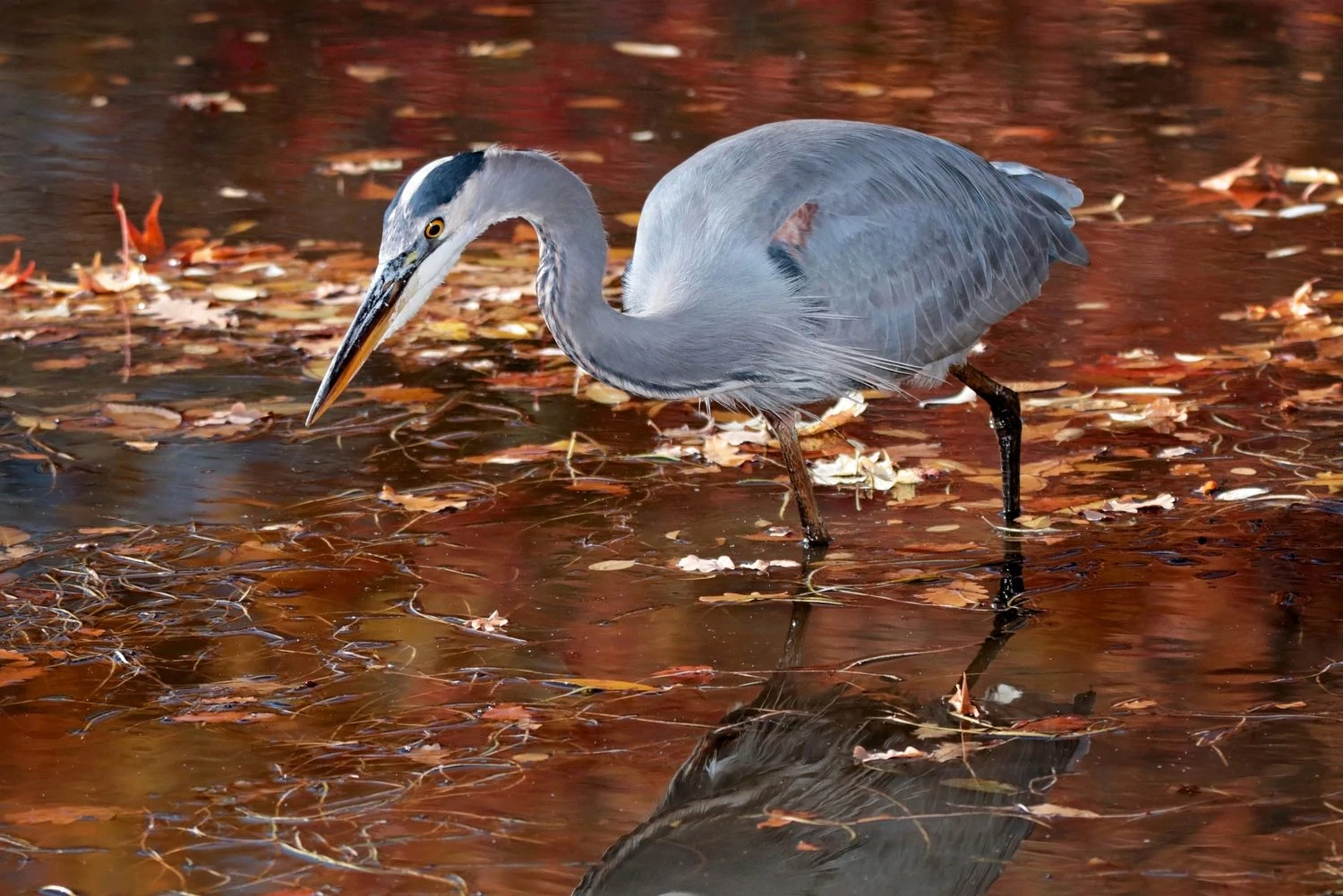
Great Blue Herons are spotted during the breeding in northern Michigan but some are spotted in the south of the state all year. They are recorded in 17% of summer checklists and 3% of winter checklists submitted by bird watchers for the state.
Great Blue Herons are very large, majestic birds that are the largest heron native to North America.
They have a white face with a black crest or plume that extends from the front of their eyes to the back of their heads. Their bills are yellow-orangish.
They have long gray necks with black and white streaking in the front, grayish-blue bodies, and long gray legs.
- Ardea herodias
- Length: 46 – 52 in (117 – 132 cm)
- Weight: 128 oz (3628 g)
- Wingspan: 77 – 82 in (196 – 208 cm)
Great Blue Herons remain in most US states all year, but those that breed in the Mid-West and Canada migrate south.
The Great Blue Heron has a white morph subspecies called the Great White Heron in Florida.
You can find Great Blue Herons in many wetland environments. They can be present in fresh and saltwater marshes, mangrove swamps, flooded marshes, lake edges, or shorelines.
Great Blue Herons’ main diet consists of fish, frogs, salamanders, shrimps, crabs, dragonflies, grasshoppers, and other aquatic insects.
They capture their prey when wading or standing in water. They may also hover over water, dive into the water, jump feet-first from perches, or float on the water’s surface.
Great Blue Heron Call:
Nests of Great Blue Herons are found in colonies, high up in trees close to water. The nests are made with twigs and sticks lined with softer material.
Since Great Blue Herons reuse their nests, they may repair and add more to the nests over time, growing them in size.
The female then lays two to seven eggs. Both parents take turns incubating the eggs for around four weeks.
Fun Fact: Great Blue Herons defend their feeding territory with dramatic wing outstretched displays, with their heads thrown back.
2. Great Egret
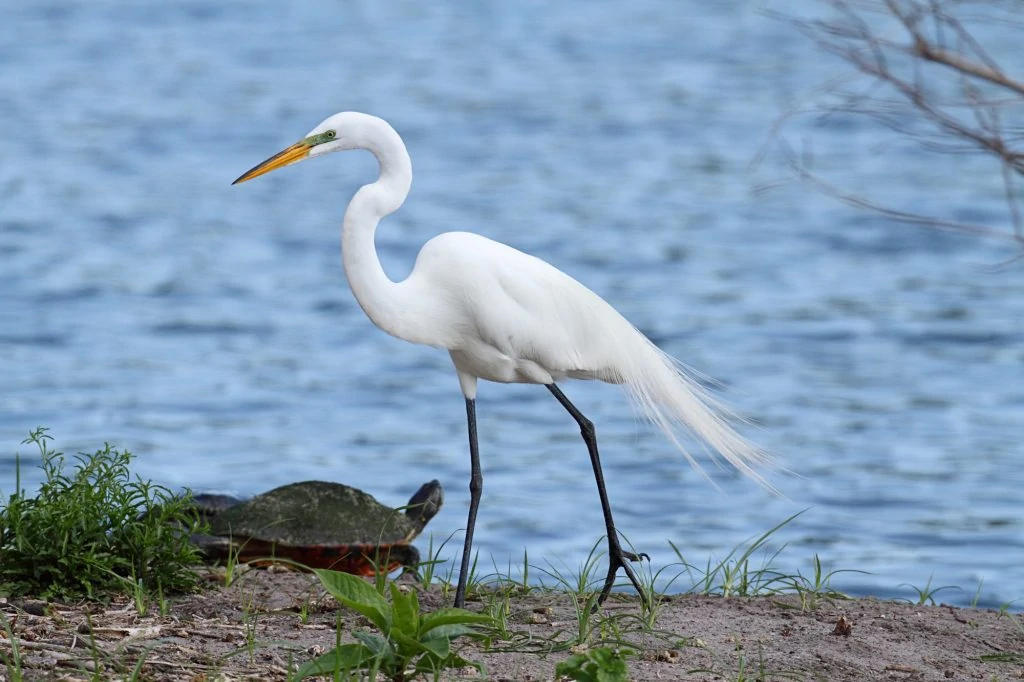
Great Egrets are mainly spotted in Michigan in summer from April to November but their numbers increase from mid-July to September. They appear in 6% of summer checklists but up to 15% of checklists during migration.
Great Egrets are at their best during the breeding season when males have neon green facial skin and long, wispy feathers (aigrettes) extending from their backs to their tails, which they show off during courtship, like how a peacock flares out its tail.
They are large, all-white herons, which is why they’re often called Great White Herons. They are also called common egrets. These large birds are white, with dagger-like, long, bright yellow bills and long, black legs and feet.
Non-breeding males, females, and juveniles look alike.
- Ardea alba
- Length: 37 – 41 in (94 – 104cm)
- Weight: 59.96 oz (1699 g)
- Wingspan: 54 – 55 in (137 – 140 cm)
Great Egrets have a vast range around the world. Those in the southern and coastal US states remain all year, but those more inland and in Canada migrate south.
You can find Great Egrets in freshwater and saltwater marshes and tidal flats, but also fish ponds.
The diet of Great Egrets consists mainly of fish, frogs, small mammals, crustaceans, and insects. You will see Great Egrets standing motionless on the water, waiting and scouting their prey, and then they strike and spear it with their long bills.
Great Egret Calls:
Nests of Great Egrets are found in colonies. They are usually placed high up in trees, preferably on islands, to protect the nests from predators like raccoons.
They are made of sticks, twigs, and stems of marsh plants. The females lay up to six eggs, and incubation by both parents is done for around twenty-five days.
Fun Fact: The Great Egret was almost hunted to extinction because of their long white feathers (aigrettes) that were mainly used to decorate ladies’ hats.
3. Green Heron

Green Herons spend the breeding season in Michigan and occur in 7% of summer checklists. They arrive in April and start to migrate in October.
Green Herons are named such because of the glossy green-black coloring of their crowns, crests, backs, and wings, but you need to get a closer look to appreciate this as they look hunched and dark from a distance.
Their bills are two-toned, dark on top and yellow at the bottom, but these turn black in the breeding season. Their iris and legs also turn from yellow to orange.
Their heads, necks, and breasts are chestnut or maroon. They have a white central stripe running down the front length of the neck. Their bellies are gray.
Juveniles are browner with dark caps and more of a crest.
- Butorides virescens
- Length: 18 – 22 in (46 – 56 cm)
- Weight: 9.17 oz (260 g)
- Wingspan: 25 – 26 in (64 – 66 cm)
Green Herons breed mainly in eastern US states and the Pacific Coast before migrating south. However, those along the Gulf Coast, the Caribbean, and Mexico remain all year.
You can find Green Herons in swamps, marshes, lakes, ponds, and other wet habitats with dense vegetation. While they prefer coastal and inland wetlands, they may stay in dry woods or orchards if there are water sources nearby.
The diet of Green Herons is small fish, insects, spiders, crustaceans, snails, amphibians, reptiles, and rodents. They usually hunt from shore by perching on sticks over the water rather than by wading.
Green Heron Call:
Nests of Green Herons are made of long, thin twigs high in the trees over water, but some may also leave them on the ground, hidden under bushes.
Females lay up to six eggs which are laid in 2-day intervals. Incubation by both parents starts only when the last egg has been laid and takes about twenty days. They both feed their young when they hatch.
Fun Facts: Green Herons are one of the few bird species to use tools for foraging using bait, like bread, feathers, twigs, and leaves to catch their prey. (Davis and Kushlan, 1994).
4. Black-crowned Night-Heron
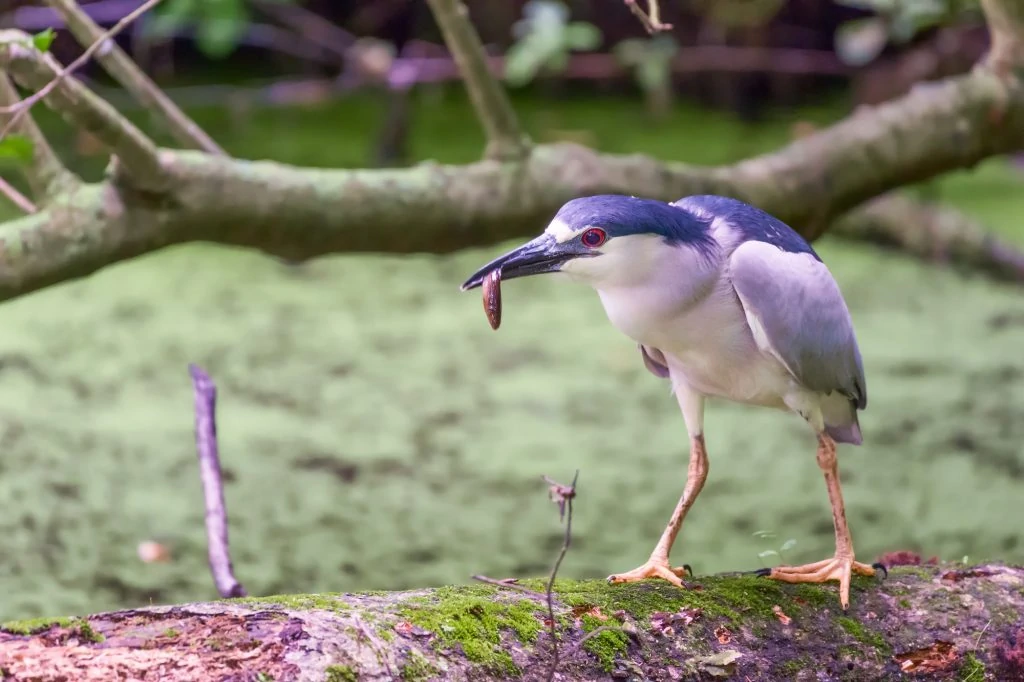
Black-crowned Night-Herons are spotted in Michigan during the breeding season, mainly from April to October, and are recorded in 1% of summer checklists.
Black-crowned Night-Herons, or simply Night Heron, do not fit the typical description of the heron family. It is quite stocky and has a shorter bill, neck, and legs.
Adult Black-crowned Night-herons have black caps that extend from a white line above their black bills.
Their eyes are red while the lores (area in front of the eye, towards the bill) are green-blue. They are white underneath and darker on the back. Their legs and feet are yellow.
During the breeding season, the black coloring of the head and back turns to a glossy blue-green, and two or three white feathers appear on the crown. The lores also turn black, and the legs and feet become red or pink.
Juveniles are a dull grayish-brown overall with some streaking and spotting.
- Nycticorax nycticorax
- Length: 25 – 28 in (64 – 71 cm)
- Weight: 38.8 oz (1100 g)
- Wingspan: 44 – 45 in (112 – 114 cm)
Black-crowned Night-herons have a vast range around the world. In North America, they breed in the US and Canada before migrating south. Some remain all year along the coasts.
You can find Black-crowned Night-herons in wetland habitats like shallow freshwater or brackish rivers. They are also used to artificial habitats like reservoirs, canals, and fish ponds.
Black-crowned Night-herons are night-feeders and feed on anything they can find, such as crayfish and fish and even turtles or worms.
Black-crowned Night Heron Call:
Nests of Black-crowned Night-herons are started by the males in preparation for choosing their mates and are usually built in bushes or trees.
The female will then lay up to seven eggs, laid at 2-day intervals. Both parents start to incubate the eggs as soon as they’re laid for about twenty-four days. The parents will take care of their young for about 3 weeks.
Fun Fact: A colony of Black-crowned Night-herons has spent their summers at the National Zoo in Washington DC, for more than a century.
5. American Bittern
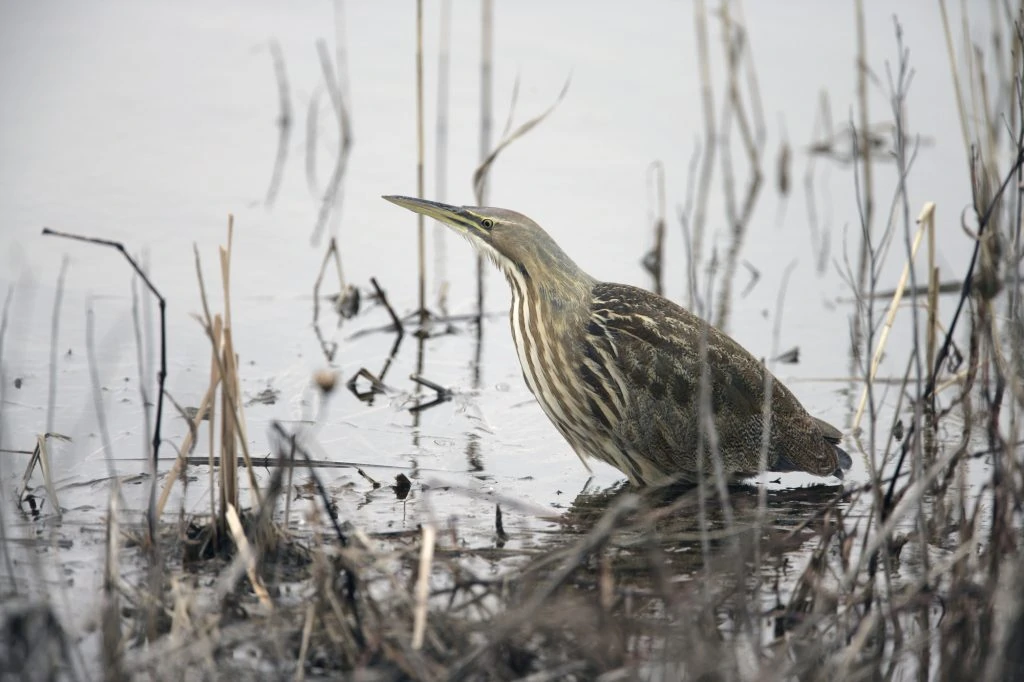
American Bitterns appear in 1% of summer checklists. They are spotted during the breeding season mainly in northern Michigan but some are also spotted during migration across the state.
If you’re lucky, you will hear the weird watery boom calls in the spring of the American Bittern long before you see them. Check them out below…
American Bitterns are chunky, medium-sized, solitary birds belonging to the Heron family.
They look like the reeds they hide in because of their brown striped and mottled patterning and their ability to stay motionless among the reeds with their head tilted up.
Their eyes are yellow but turn orange during courtship, and they have short legs.
- Botaurus lentiginosus
- Length: 23 in (58 cm)
- Weight: 25.6 oz (726 g)
- Wingspan: 42 – 50 in (107 – 127 cm)
American Bitterns breed in Canada and northern US states before migrating to the Gulf Coast and Mexico.
You can find American Bitterns almost exclusively in shallow, freshwater marshes and wetlands with tall reeds.
Train your eyes on the edges of lakes and ponds amid the coarse vegetation to find them.
The diet of American Bitterns is fish, crustaceans, insects, amphibians, and small mammals. They forage stealthily amongst the reeds, staying still and silent, waiting for their prey to come closer, and then dart forward quickly to capture them in their bills.
American Bittern Calls: Listen to their strange watery boom calls. It is one of the weirdest bird calls.
Nests of American Bitterns can be found on the water, concealed among coarse vegetation. Females choose the nest site and build it themselves with available reeds, sedges, cattails, and other vegetation.
They lay up to seven eggs which are incubated for around twenty-six days. The chicks, when hatched, are fed by the females through regurgitation directly into their beaks. In two weeks, they leave the nest and are fully-fledged in six to seven weeks.
Fun Fact: American Bitterns point upwards and sway gently from side to side, just like the reeds that hide them to conceal themselves.
6. Least Bittern
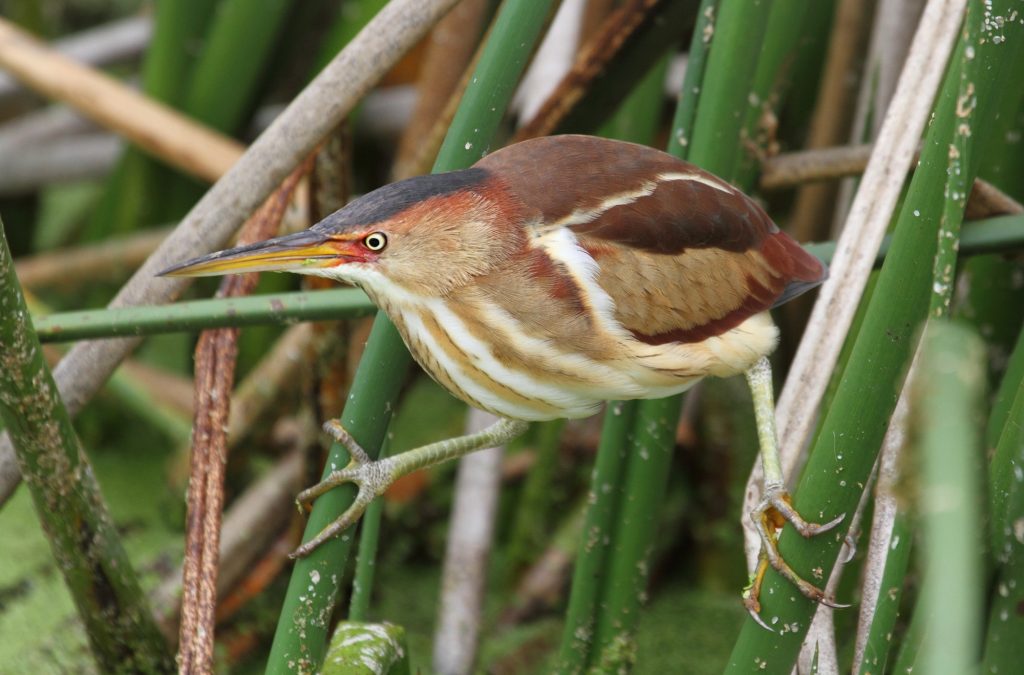
Least Bitterns are usually spotted in Michigan from April to November but they are most common from May to August.
Least Bitterns are the smallest herons in the Americas and pretty hard to find in the reeds, but you may hear them first.
They are shades of brown and white, with a dark cap and dark top to their yellow bill. They have long toes and claws, which they use to grip the reeds.
Adult females and juveniles are similar to males but with lighter backs and crowns.
- Ixobrychus exilis
- Length: 11 – 14 in (28 – 36 cm)
- Weight: 3 oz (85 g)
- Wingspan: 16 – 18 in (41 – 46 cm)
Little Bitterns’ usual range is Europe and Africa, but they occasionally stray into North America.
You can find Least Bitterns in dense freshwater and brackish marshlands with many tall cattails and reeds. Look for them as they perch on reeds.
When they sense danger, they will immediately freeze up, raise their bills to the sky, and sway in time with the reeds.
Least Bitterns’ diet includes small fish, frogs, tadpoles, salamanders, slugs, dragonflies, aquatic bugs, and sometimes, mice. They position themselves on the reeds, sometimes performing acrobatic contortions just to reach their prey on the surface of the water.
Least Bittern Calls:
Nests of Least Bitterns are well-concealed platforms built by the female from cattails and marsh vegetation. She lays up to seven eggs, and both parents incubate them for about twenty days. Then, they feed newly-hatched chicks by regurgitating food.
Fun Fact: Least Bitterns have long necks but usually stay in a hunchbacked position.
7. Snowy Egret
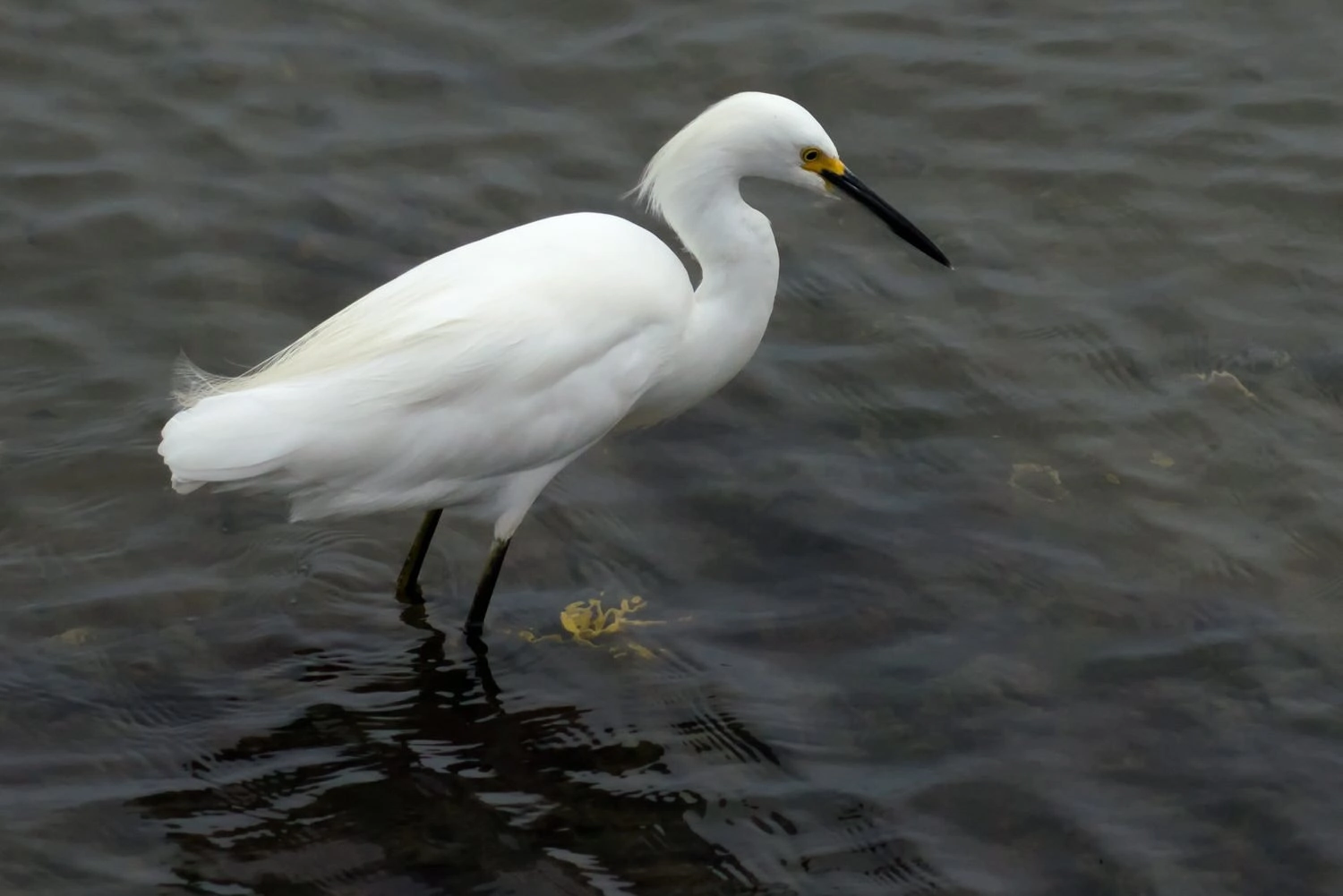
Snowy Egrets are not very common in Michigan and although there have been sightings here during summer, from April to October, they are more common from mid-July to August.
Snowy Egrets, as their name suggests, are small, all-white herons. They have yellow irises and skin around their eye, long, black bills, long, black legs, and bright yellow feet.
During the breeding season, long, lacy feathers appear on their heads, necks, and backs. Their lores or facial skin turn reddish-pink, and their toes turn orange-red during courtship.
Interestingly, these areas of their bodies also become bright red during aggressive encounters.
Juveniles are similar to adults but without head plumes. The colors on their bills and legs are also lighter, with lores and legs more greenish-yellow.
- Egretta thula
- Length: 22 – 27 in (56 -69 cm)
- Weight: 16.75 oz (475 g)
- Wingspan: 39.4 in (100 cm)
Snowy Egrets migrate from most US states, except along the Gulf Coast and southwest coast. They remain all year in Mexico, Central, and South America.
You can find Snowy Egrets in shallow, wetland habitats such as marshes, riverbanks, lakesides, pools, salt marshes, and estuaries. For nesting, they prefer swamp forests with protective trees and bushes.
Snowy Egrets hunt in shallow water for fish, crustaceans, snails, frogs, and crayfish. They may stand still and wait for prey to come to them or may also disturb the water to bring their prey to the surface to make it easier for them to catch.
Snowy Egret Call:
Nests of Snowy Egrets are chosen by the males. They select the location and go on full display to attract their mates. When they pair up, the males continue to supply sticks, sedges, or reeds while the female builds the nest.
Nests are usually located in trees or concealed in shrubs on the ground. The female then lays two to six eggs, and both parents take turns incubating their eggs. Incubation usually lasts twenty-four days.
Fun Fact: Snowy Egrets were almost hunted down to extinction because of their beautiful white head feathers that were the perfect decoration or accessory to women’s hats.
8. Cattle Egret
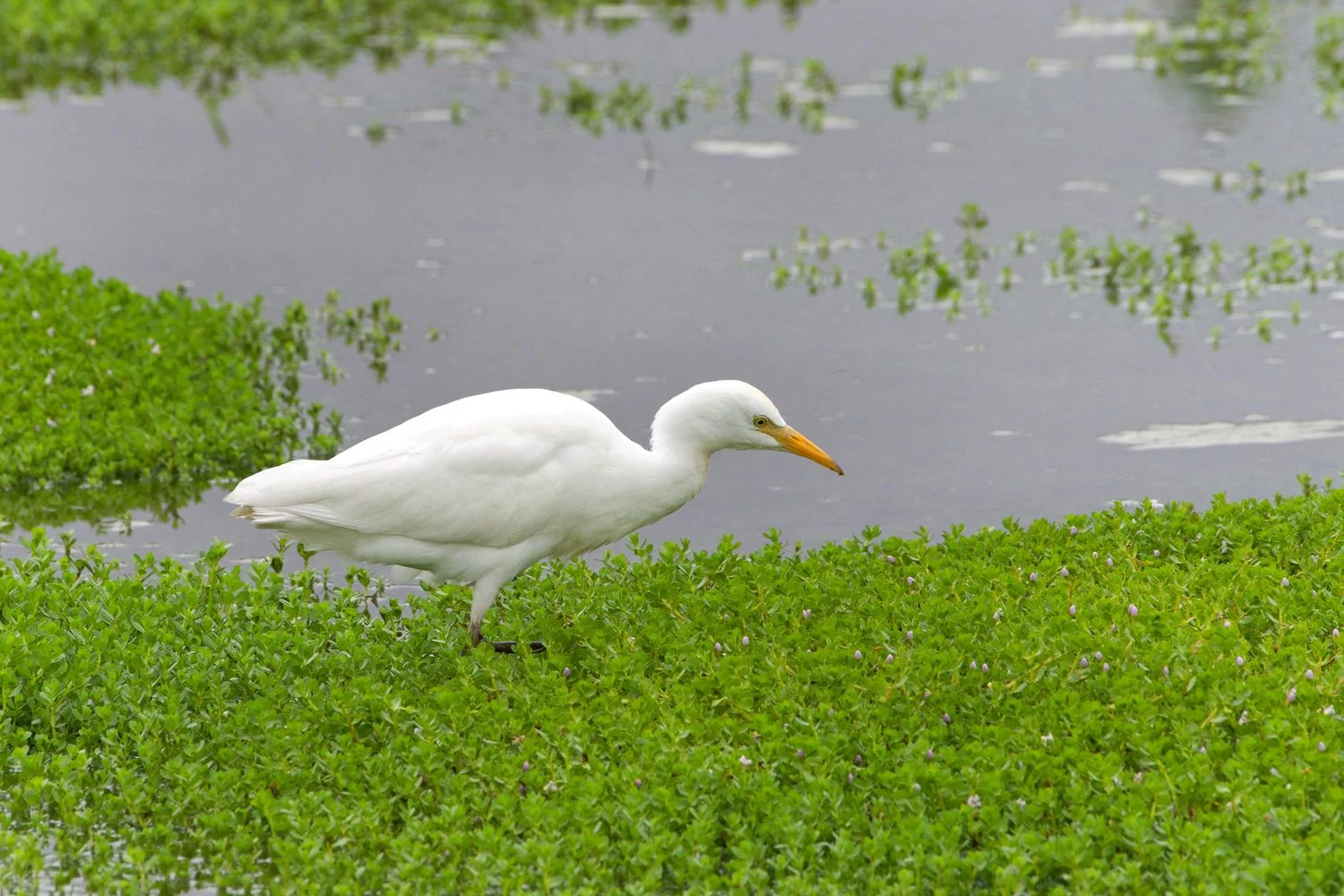
Cattle Egrets are usually spotted in Michigan during migration but they are not very common here.
Cattle Egrets have a smart way of catching their food…they stand on the backs of cattle, so when the cattle move and disturb the ground, they catch the disturbed prey.
Cattle Egrets are small, short-necked egrets with white bodies and pale orange-brown patches on their heads, necks, and backs.
Their irises and facial skin are yellow. They have short, yellow bills and short greenish-black legs. Males and females look similar.
Cattle Egret change color throughout the year and they become brighter, especially on legs and face during the breeding season.
During the breeding season, their pale orange patches become darker orange. Their bills, legs, and irises become bright red, and facial skin (lores) turn pinkish-red at the height of their courting.
- Bubulcus ibis
- Length: 19 – 21 in (48 – 53 cm)
- Weight: 17.98 oz (510 g)
- Wingspan: 36 – 38 in (91 – 97 cm)
Cattle Egrets have a vast range around the world, but within North America, those in the south in Mexico, the Gulf Coast, and southwestern US states remain all year.
However, those that breed further north, mainly in eastern US states, migrate south after breeding.
You can find Cattle Egrets in native grasslands, pastures, crop fields, and rice fields, especially where there is hoofed livestock.
While they prefer to stay on land and on top of cattle, they do venture into the edges of aquatic environments, like riverbanks, ponds, and shallow marshes. They may also be spotted in golf courses, lawns, athletic fields, dumps, and parks.
Cattle Egrets’ diet is insects, mostly grasshoppers, crickets, flies, beetles, and moths. They also eat spiders, frogs, small snakes, lizards, earthworms, and fish.
Cattle Egret Calls:
Nests of Cattle Egrets are made from sticks and reeds and are usually built in colonies in woodlands near lakes or rivers, in swamps, or on small islands.
The female lays up to nine eggs which they incubate for about twenty-five days. It takes about forty-five days for the young to grow, fledge and become fully independent from their parents.
Fun Fact: The Cattle Egret’s eyes have adapted to foraging on land by having binocular vision for judging distance to catch prey on land rather than correcting for light refraction when feeding in water.
9. Little Blue Heron
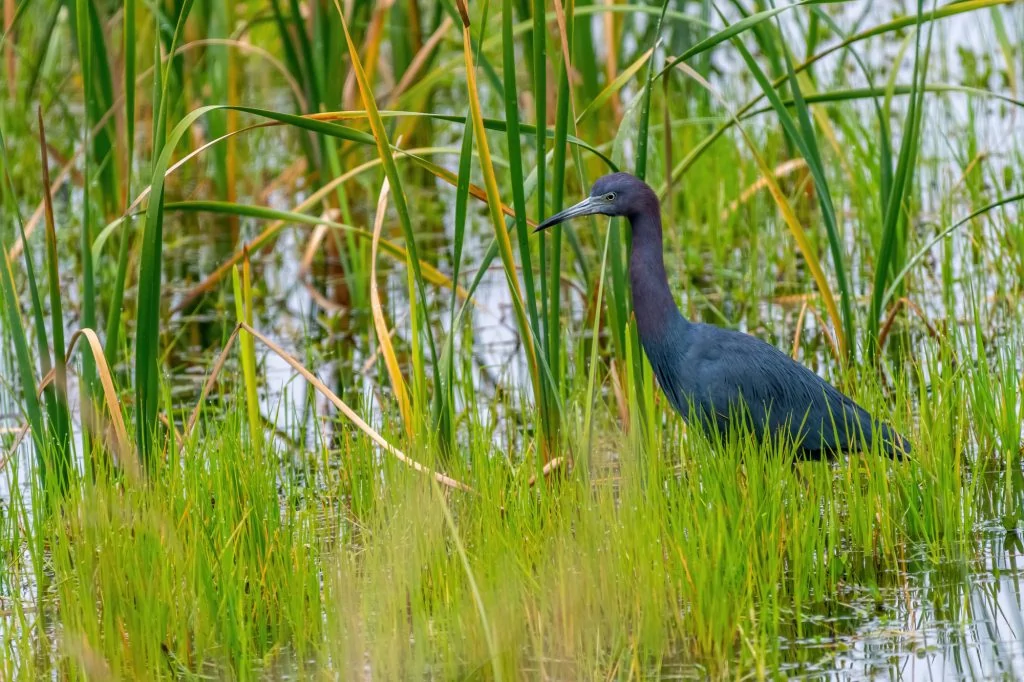
Little Blue Herons are spotted in southeastern Michigan during migration, but they are not common here.
Adult Little Blue Herons are actually not so little. They’re medium to large-sized with long, elongated bodies. Their heads and necks have a purplish hue with dangling feathers across the nape.
Their eyes are pale yellow and may turn gray-green during the breeding season. Their long, dagger-like bills are two-toned – pale blue or grayish with black tips. Their bodies are slate-blue. Their legs are long and black to gray-green.
Juvenile Little Blue Herons are totally white during their first year of life before becoming a mix of dark gray, blue, and white.
- Egretta caerulea
- Length: 24 – 29 in (61 – 74 cm)
- Weight: 16.22 oz (460 g)
- Wingspan: 40 – 41 in (102 – 104 cm)
Little Blue Herons breed in eastern US States before migrating south, but those along the Gulf Coast and Mexico into south America remain all year.
You can find Little Blue Herons around water, whether in swamps, marshes, ponds, streams, lagoons, tidal flats, canals, ditches, fish hatcheries, or flooded fields.
Little Blue Herons forage in a more graceful motion compared to other herons. Rather than dashing about across the water, they merely stand and wait in shallow waters for their prey.
The diet of Little Blue Herons is fish, frogs, snakes, turtles, spiders, crustaceans, mice, and insects. Adults tend to forage alone, while juveniles prefer to stay with mixed groups.
Little Blue Heron Calls:
Nests of Little Blue Herons are made from sticks and usually in colonies with other herons. The female lays up to six eggs. Both parents also share in the incubation for up to twenty-four days.
Fun Fact: Because of the white coloring of Juvenile Little Blue Herons, their presence among Snowy Egrets so they can catch more fish and have extra protection against predators.
10. Yellow-crowned Night-Heron
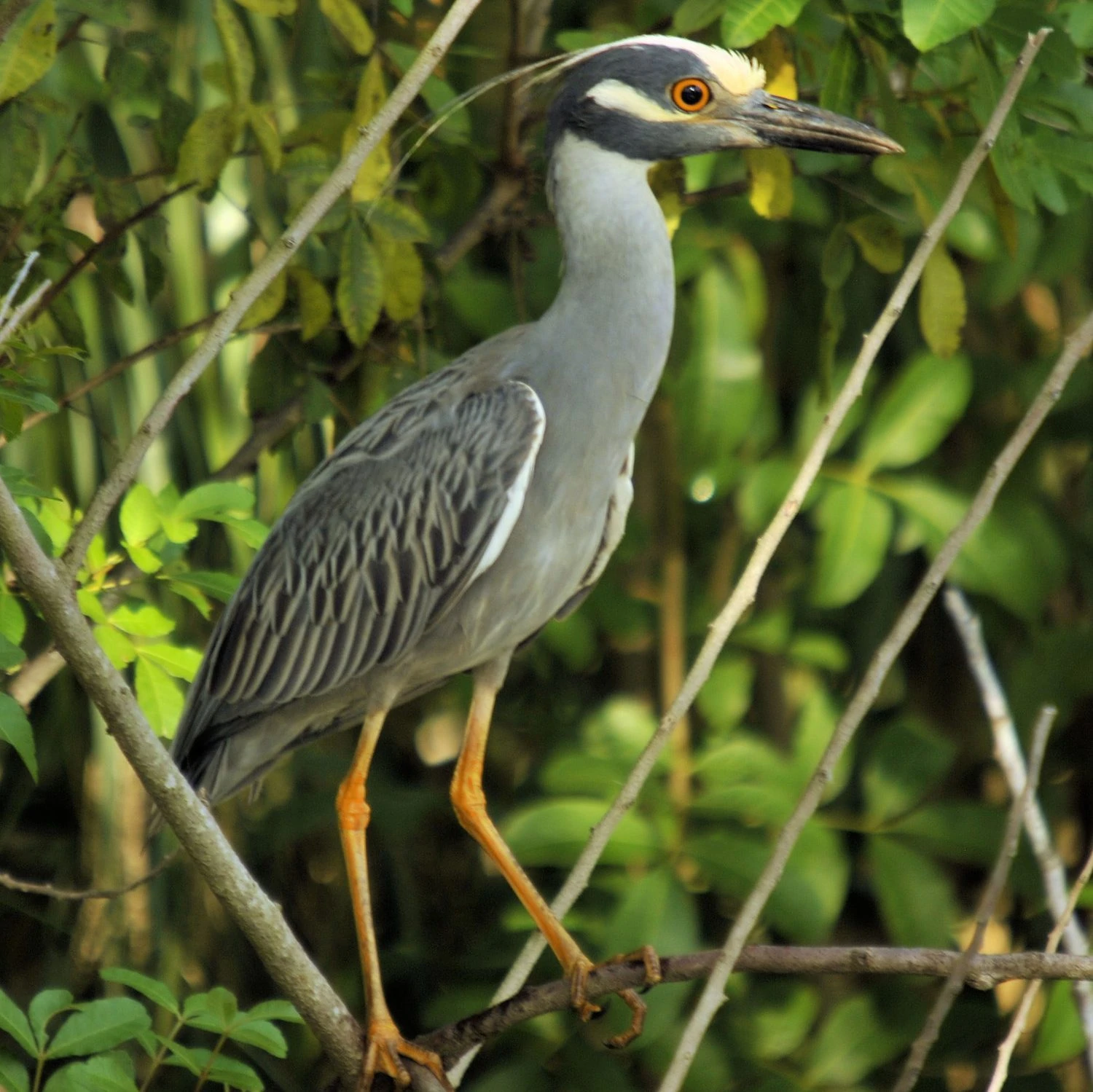
Yellow-crowned Night-Herons are considered rare or accidental species in Michigan but you might spot some in the southeast of the state during migration.
Adult Yellow-crowned Night Herons have yellow crowns with 2 plumes extending from their heads. Their large bills are black. The rest of their heads are black, with a small white patch on the sides below their eyes.
They have red eyes that change from yellow to orange to red as they grew up.
Their bodies are gray-blue with a scaled pattern on their wings. Their legs are long and yellow and turn coral, pink, or red during the breeding season.
Juveniles start grayish-brown all over with some white streaks and spots. They take three years to resemble adults.
- Nyctanassa violacea
- Length: 22 – 28 in (56 – 71 cm)
- Weight: 25.6 oz ( 726 g)
- Wingspan: 42 0 44 in (107 – 112 cm)
Yellow-crowned Night-herons breed mainly in southeastern US states before migrating south. They remain all year in Mexico, the Caribbean, and northern South America.
You can find Yellow-crowned Night-herons at dawn and dusk in coastal areas with a lot of crustaceans, shallow waters, and significant edges on which to feed.
The diet of Yellow-crowned Night-herons is mostly crustaceans like crabs and crayfish. They also eat fish, insects, worms, mollusks, lizards, snakes, rodents, and birds. They can swallow small prey instantly.
Crabs are often dismembered or stabbed through their bodies.
Yellow-crowned Night Heron Call:
Nests of Yellow-crowned Night-herons are often found in small, loose colonies, but they always build nests near water. The nests are made by both parents from sticks and twigs made soft with grass, leaves, or moss.
She then lays up to eight eggs which they incubate together for about three weeks. When they hatch, the chicks are fed by regurgitation. They fledge in about a month and, at fifty days, can fly on their own.
Fun Fact: Yellow-crowned Night-heron can carry a deadly mosquito-borne virus (eastern equine encephalomyelitis (EEE) virus) that can kill horses and humans.
11. Tricolored Heron
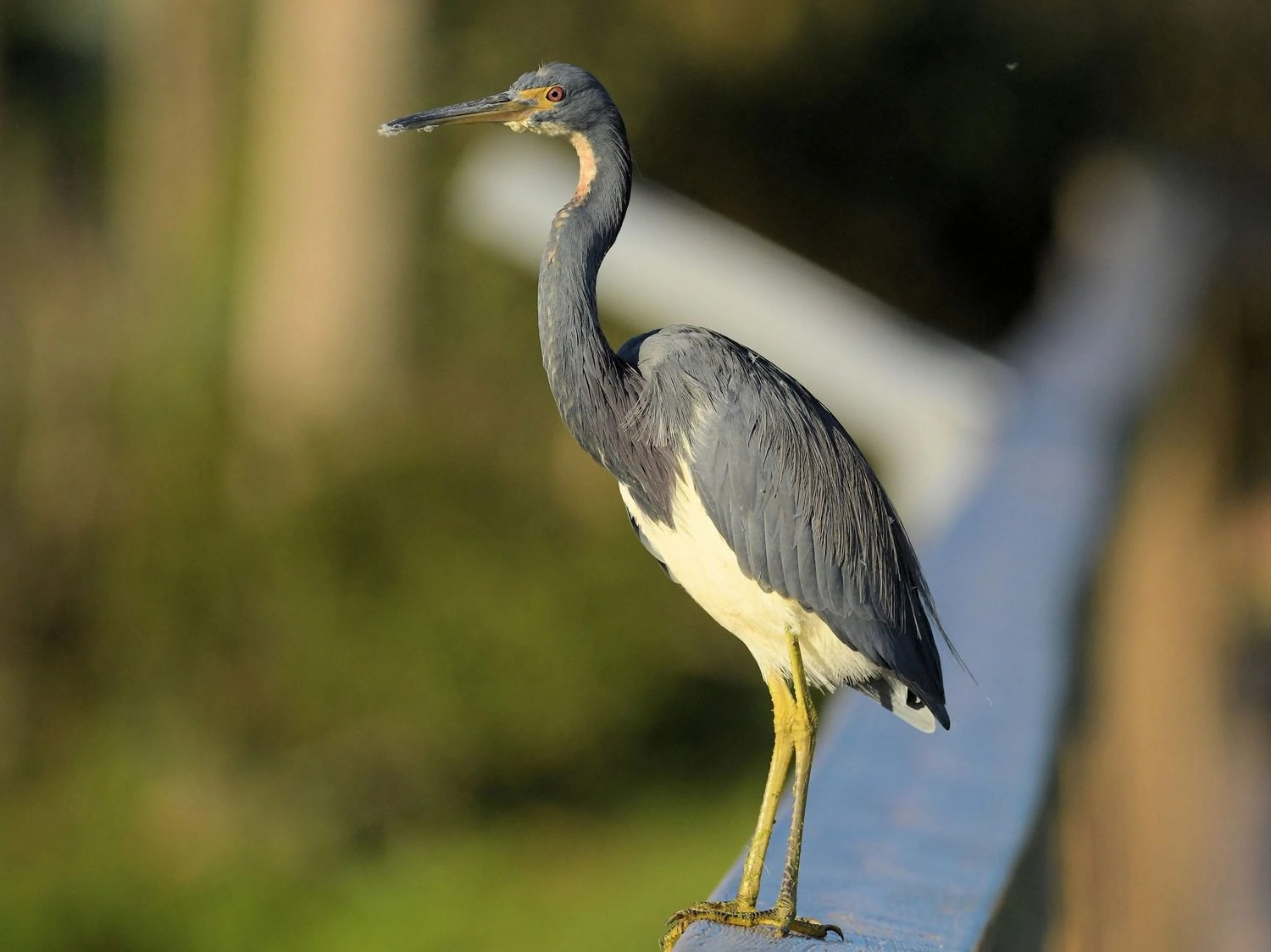
Tricolored Herons are extremely rare in Michigan and are considered accidental species in the state. However, there have been recent sightings around Erie in 2022.
You can quickly tell a Tricolored Herons apart from other herons with its white belly and neck stripe.
Non-breeding adults have a combination of blue-gray, purple, and white feathers. Their bills are yellowish or greyish with a black tip. Their legs and feet are yellow or olive green.
Breeding adults also have thin, white feathers extending from the back of their heads, and the base of their bill becomes blue. They also have finer feathers on their necks and back. Their legs also become reddish in color.
Juveniles are more reddish-brown, particularly in their neck, upper breasts, upper back, and wings.
- Egretta tricolor
- Length: 24 – 26 in (61 – 66 cm)
- Weight: 14.6 oz (414 g)
- Wingspan: 36 in (91 cm)
Tricolored Herons remain all year along the Gulf Coast, Mexico, and northern South America. Those that breed further north along the Atlantic Coast migrate south.
You can find Tricolored Herons in freshwater and brackish marshes, estuaries, and coastal tidal pools or swamps.
Tricolored Herons are solitary feeders and are defensive of their feeding grounds. They will chase away other wading birds that attempt to feed on their territory and love to eat small fish, frogs, crustaceans, and insects.
Expect to see them stalking, chasing, standing, and waiting to catch their prey. They crouch low on the water, with their bellies touching the surface and their necks drawn in, before striking.
Tricolored Heron Call:
Nests of Tricolored Herons are made from sticks and made in colonies in trees and shrubs. The female then lays three to five eggs, and both parents share in the incubation, which takes them three weeks before the eggs hatch. They also both feed the young.
Fun Fact: The Tricolored Heron used to be known as the Louisiana heron and is the only dark-colored heron with a white belly.
12. Reddish Egret
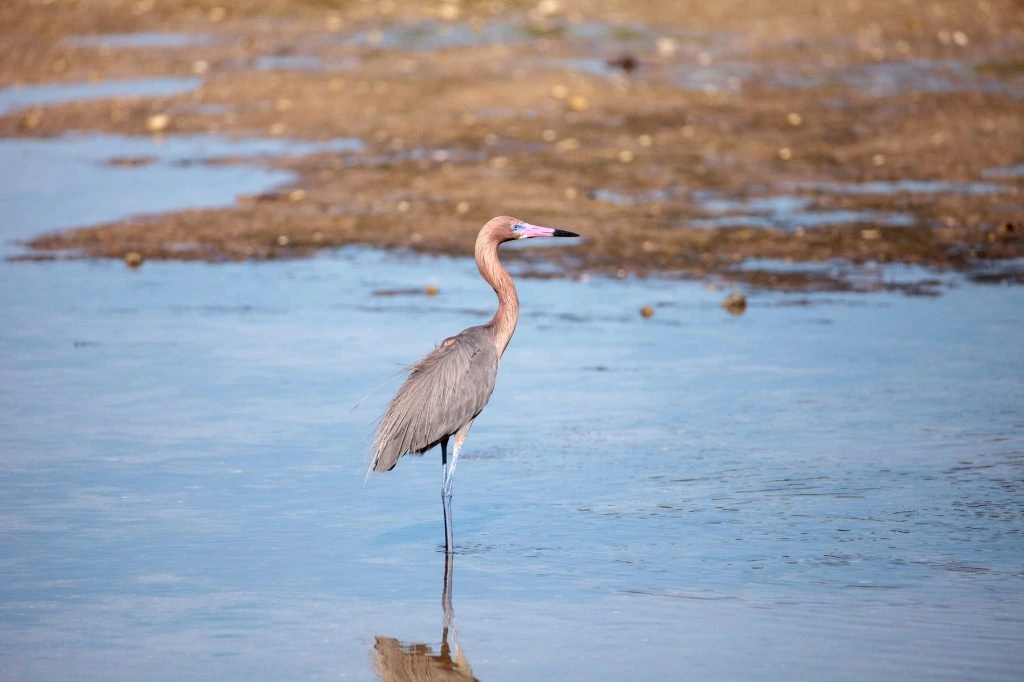
Reddish Egrets are extremely rare birds to see in Michigan but they have been accepted by the Michigan Bird Records Committee, as accidental species in the state.
Reddish Egrets’ dusky pink and grayish-blue tones and energetic racing about to catch fish certainly make this one of the best birds to watch.
Although they are called Reddish Egrets, they actually come in dark and light morphs, although white morphs are rare.
Dark morph Reddish Egrets have blue-gray bodies and cinnamon-toned heads, necks, and breasts. Their bills are pink with a black tip.
White morphs have entirely white bodies. However, they both have straw yellow eyes with darker skin around (lores) and their legs and feet are blue-black.
Juveniles are also dark or white, and adults will mate with either morph.
- Egretta rufescens
- Length: 27 – 32 in (69 – 81 cm)
- Weight: 15.9 oz (451 g)
- Wingspan: 46 in (117 cm)
Reddish Egrets remain all year along the Gulf Coast, East Coast, and Mexico down to northern South America.
You can find Reddish Egrets in open marine flats and shorelines. They also inhabit marshes, shallow bays, and lagoons.
Generally, Reddish Egrets forage and feed alone. They run across shallow, flooded flats in hopes of catching fish. When they’re successful in scaring fish up, they immediately stab them with their beaks.
Reddish Egret Call:
Nests of Reddish Egrets are often in colonies and built by both parents into a platform of sticks. They are usually on protected islands with nearby feeding areas.
The female lays up to seven eggs that take twenty-five days to incubate by both parents. They both care for the young even when they leave the nest and will feed their young for up to nine weeks.
Fun Fact: During mating, the male’s feathers puff out and stand out on its head, neck, and back, and he will perform a head toss display and beak snapping.
How Frequently Herons Are Spotted In Michigan In Summer And Winter
Checklists are a great resource to find out which birds are commonly spotted in your state. These lists show which herons are most frequently recorded on checklists on ebird in summer and winter in Michigan.
Herons in Michigan in summer:
Great Blue Heron 17.7%
Green Heron 7.5%
Great Egret 6.8%
Black-crowned Night-Heron 1.6%
American Bittern 1.3%
Least Bittern 0.7%
Snowy Egret 0.1%
Cattle Egret 0.1%
Yellow-crowned Night-Heron 0.1%
Tricolored Heron <0.1%
Little Blue Heron <0.1%
Herons in Michigan in winter:
Great Blue Heron 2.9%
Black-crowned Night-Heron <0.1%
Great Egret <0.1%
American Bittern <0.1%
Green Heron <0.1%
Cattle Egret <0.1%
Least Bittern <0.1%

